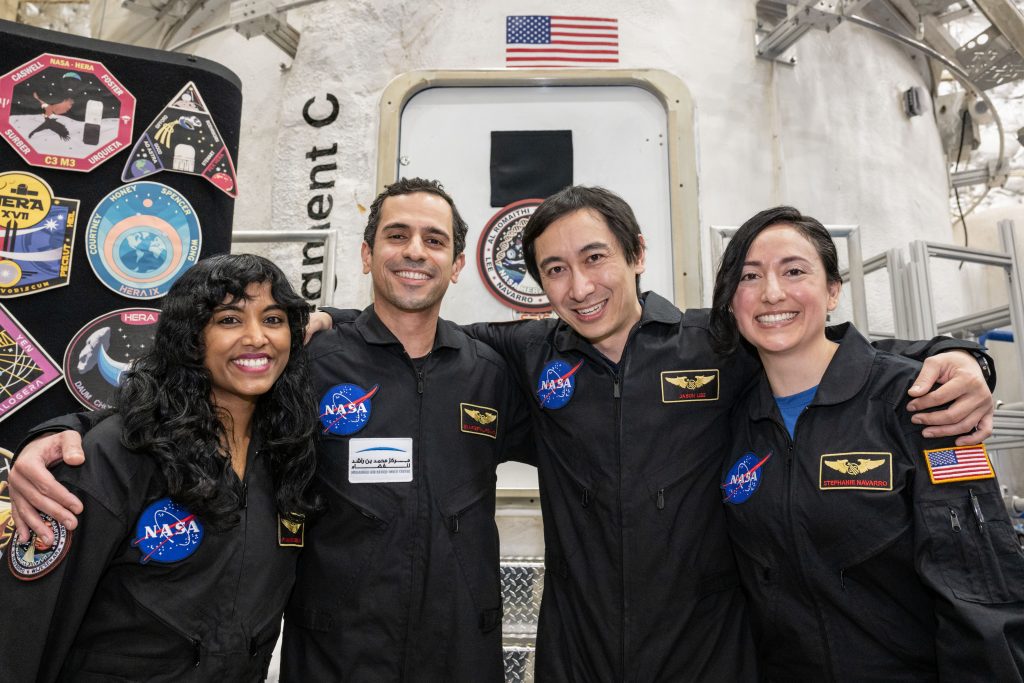Ever since his childhood, University of Connecticut professor Jason Lee has been fascinated by space and human space travel.
“I heard a webinar a couple of years ago, and one of the speakers mentioned that she is an analog astronaut,” Lee said. “When I looked it up, I ran across NASA’s Human Exploration Research Analog (HERA) website. The application for this analog was very short and straightforward, so I gave it a shot, not thinking I would hear back. It was about a year later that I got a call – and the closer I got to getting the opportunity, the more excited I became.”
Lee, a mechanical engineering professor at UConn, spent 45 days in a NASA simulation designed to study the physiological and psychological effects on crew members during long-duration space missions.
He credits his father, an aerospace propulsion engineer, for sparking his interest in space exploration. Lee remembers his father’s home office being filled with space memorabilia, which inspired his passion for the field, according to a press release by UConn Today.
“He is the reason I became interested in engineering,” Lee said in an interview with UConn Today. “Since he passed a number of years ago, I’ve found I feel closer to him whenever I do work related to space. Just like many of my students, I’ve always dreamed of being an astronaut, and participating in this simulation mission helped me fulfill part of that dream.”
Lee’s father’s influence is likely the catalyst for his recent NASA research opportunity. He continues to honor his father’s memory by pursuing aerospace research whenever possible, such as during this analog mission.
NASA defines analog missions as “field tests in locations that have physical similarities to the extreme space environments.” The goal is to test new technologies and human behavior in harsh conditions before they are used in space.
Lee and his fellow crew members used equipment similar to what astronauts would use in space, including flight suits and custom mission badges. Some of the tools they used were repurposed from previous space missions, according to CT Insider.
For the simulation, Lee lived in a 650-square-foot capsule at NASA’s Johnson Space Center in Houston with three crew members he had never met before.
“Initially, I was preparing myself to struggle to feel comfortable and not be annoyed by my crewmates since I didn’t know them,” Lee said. “But the training team did a good job helping us bond and work together during the two-week training period.”
Inside the habitat, the crew followed a structured daily routine while also having time to relax and interact socially. Although they were not allowed to use their phones or personal computers, the crew was able to play games, read books, watch movies, exercise, and listen to music, according to UConn Today.
Lee and his fellow crew members participated in a variety of team-based activities that simulated emergencies astronauts might face in space. While the details of these simulations are confidential, one exercise stood out to Lee as particularly enjoyable.
During Martian spacewalks, Lee and the flight engineer would step into the airlock to pressurize or depressurize it to match the atmospheric pressure on Mars before embarking on a virtual walk on the planet. They used virtual reality headsets to communicate with the other two crew members, who were flying virtual drones on the main floor of the habitat, navigating and assigning tasks to the spacewalkers.
“We had so much fun during these spacewalks – strategizing ahead of time, singing and joking through the comms during long walking periods, and eagerly anticipating our scores,” Lee said. “There were a number of ‘emergencies’ during those tasks that were also very interesting – but of course, I can’t share those either.”
The crew had two hours to complete each round of the spacewalk simulation, and at the end of each round, they were scored on their teamwork and problem-solving.
The crew communicated with their families once a week, following the typical lifestyle of astronauts on real space missions. While it was strange not to have access to his phone or the internet, Lee said it was calming to be free from constant digital distractions.
“It was strange not having my phone and the internet at my fingertips,” Lee said. “But after the first few days, because of how busy they kept us, it was actually calming to be away from that constant stimulation. It was strange not to talk to family for so long – we could communicate in a limited capacity once a week with time delay. In the middle of the mission, the time delay was longer, and we didn’t get to talk to them.”
Between calls, the crew was able to send audio recordings and text files.
Throughout the mission, each crew member wore a heart rate monitor that recorded stress levels and the physical effects of stress on each individual. Lee found that looking at the heart rate monitors and practicing breathing exercises could help reduce those levels.
Now looking back at his experience, Lee said he plans to incorporate his key findings into his classes at UConn.
“The two things I will bring back are the importance of teamwork and effective communication,” Lee said. “We did a number of team-based and communication-based activities that I will integrate into my classes – especially my project-based courses.”
Lee believes in the importance of communication, particularly in group settings.
“I encourage my teams to do something similar and remind them that when they struggle together, they grow together as well,” Lee said. “That was our experience when we were designing our crew patch and putting together our flight suits. A little bit of struggle in a team is a good thing.”
Lee’s experience has translated into his relationships at UConn, where his colleagues have noticed his improved communication skills and unique perspectives on teamwork, stress management, and problem-solving.
“Working with Professor Lee at UConn means having a supportive colleague and friend who values, first and foremost, the people around him,” said Dr. Horea Ilies, professor and director of the School of Mechanical, Aerospace, and Manufacturing Engineering. “His time in NASA’s HERA program underscores his commitment to hands-on education, emphasizing experiential learning and practical applications of engineering principles.”
Ilies and others at UConn have congratulated Lee on his accomplishment, noting that it reflects UConn’s emphasis on state-of-the-art research and education.
“His involvement in a high-stakes NASA simulation not only fulfills a personal dream but also highlights UConn’s significant focus on research and education,” Ilies said.
Lee’s involvement with NASA has helped elevate UConn’s reputation and could encourage future research partnerships and funding opportunities for the university.



